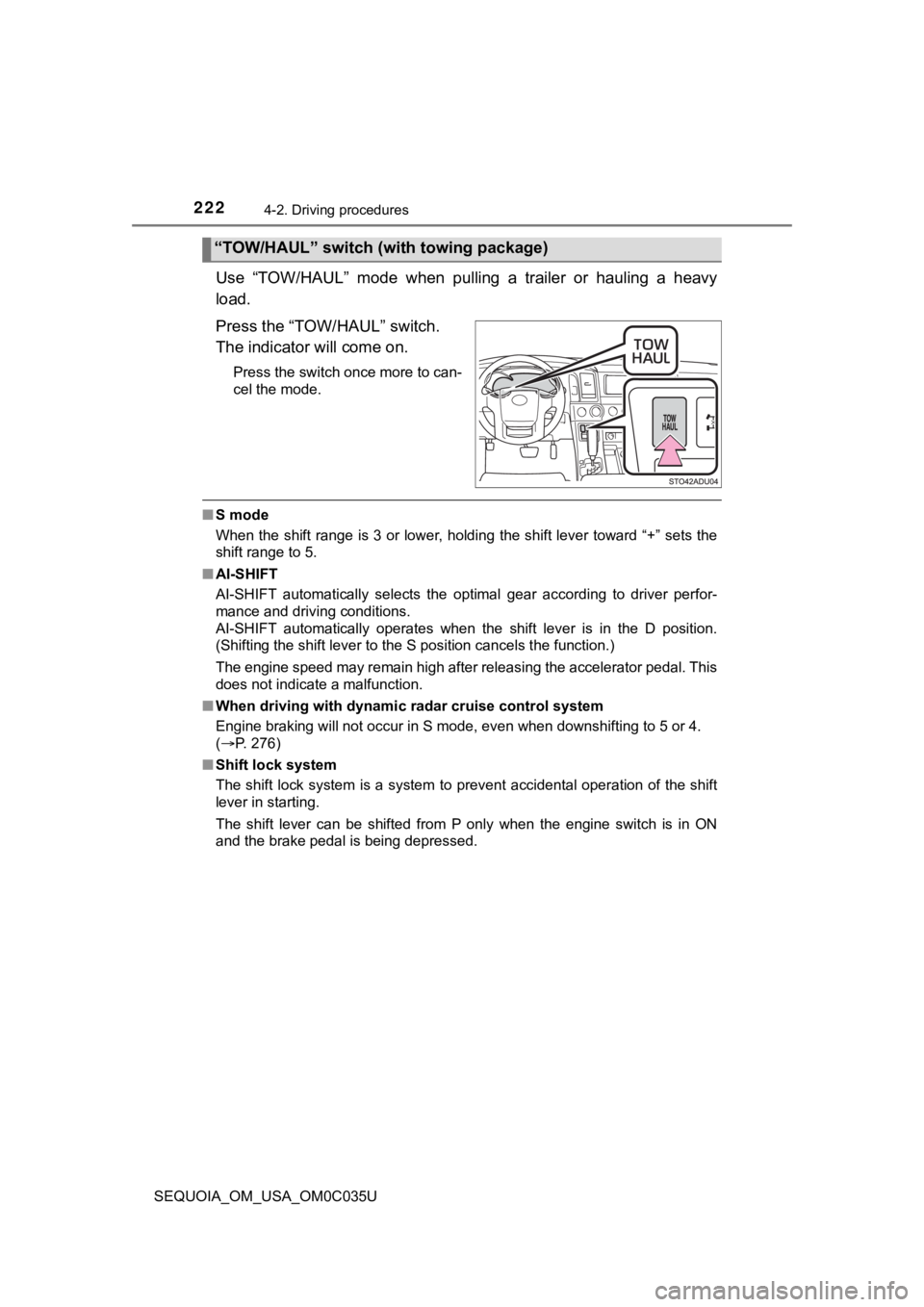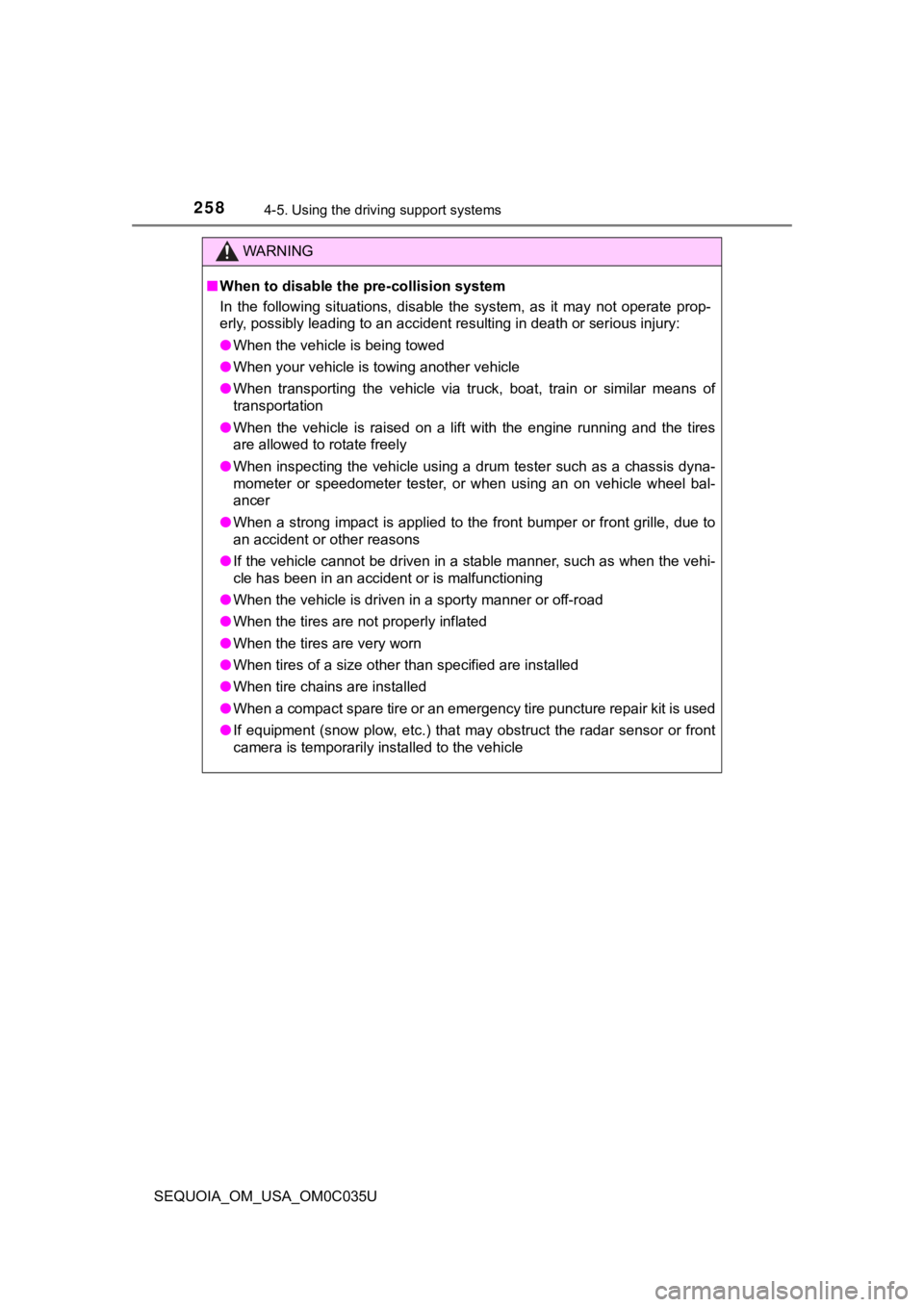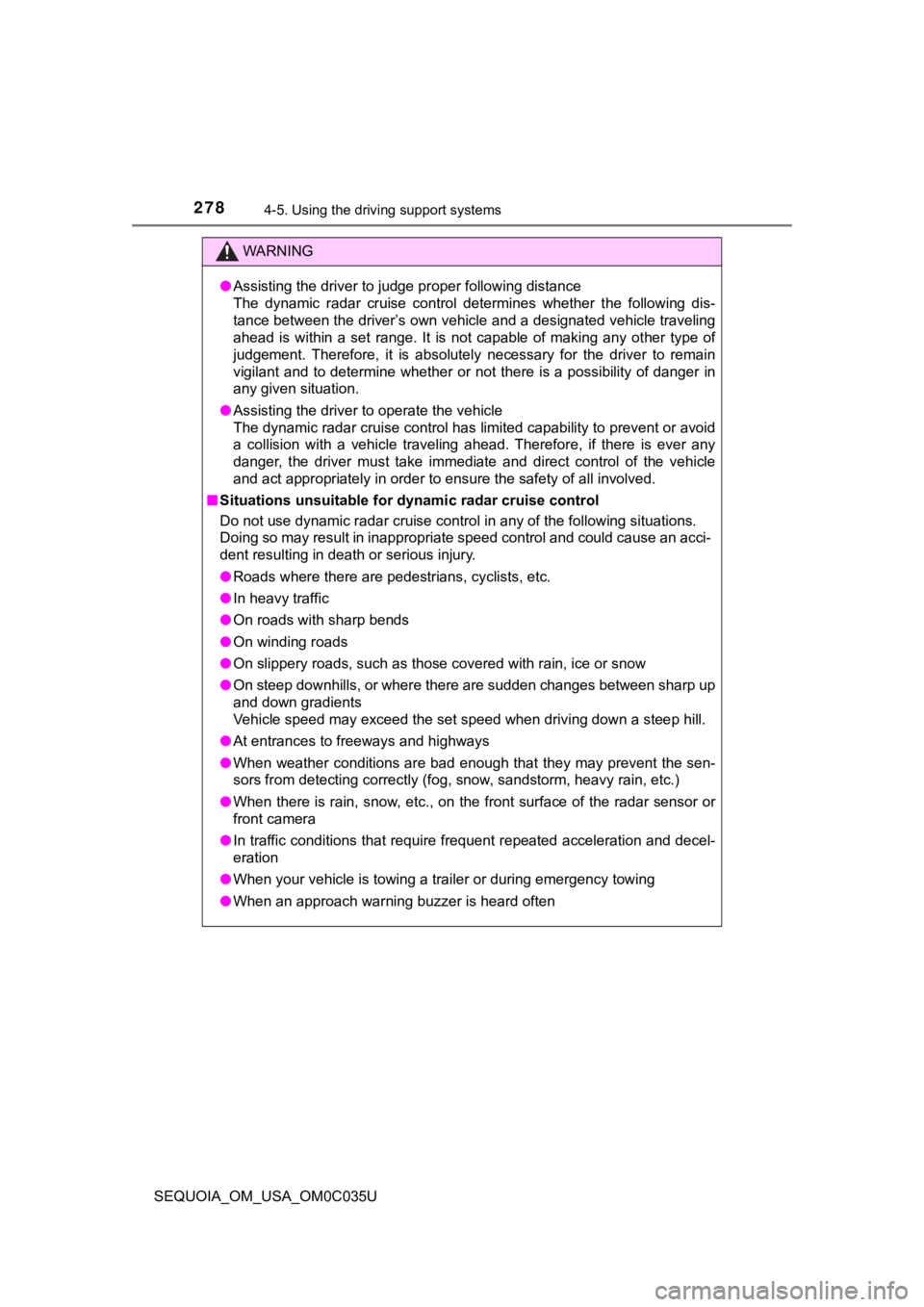towing TOYOTA SEQUOIA 2021 (in English) Owner's Manual
[x] Cancel search | Manufacturer: TOYOTA, Model Year: 2021, Model line: SEQUOIA, Model: TOYOTA SEQUOIA 2021Pages: 588, PDF Size: 12.76 MB
Page 222 of 588

2224-2. Driving procedures
SEQUOIA_OM_USA_OM0C035U
Use “TOW/HAUL” mode when pulling a trailer or hauling a heavy
load.
Press the “TOW/HAUL” switch.
The indicator will come on.
Press the switch once more to can-
cel the mode.
■S mode
When the shift range is 3 or lower, holding the shift lever tow ard “+” sets the
shift range to 5.
■ AI-SHIFT
AI-SHIFT automatically selects the optimal gear according to driver perfor-
mance and driving conditions.
AI-SHIFT automatically operates when the shift lever is in the D position.
(Shifting the shift lever to the S position cancels the functio n.)
The engine speed may remain high after releasing the accelerato r pedal. This
does not indicate a malfunction.
■ When driving with dynamic r adar cruise control system
Engine braking will not occur in S mode, even when downshifting to 5 or 4.
( P. 276)
■ Shift lock system
The shift lock system is a system to prevent accidental operation of the shift
lever in starting.
The shift lever can be shifted from P only when the engine swit ch is in ON
and the brake pedal is being depressed.
“TOW/HAUL” switch (with towing package)
Page 258 of 588

2584-5. Using the driving support systems
SEQUOIA_OM_USA_OM0C035U
WARNING
■When to disable the pre-collision system
In the following situations, disable the system, as it may not operate prop-
erly, possibly leading to an accident resulting in death or ser ious injury:
● When the vehicle is being towed
● When your vehicle is towing another vehicle
● When transporting the vehicle via truck, boat, train or similar means of
transportation
● When the vehicle is raised on a lift with the engine running an d the tires
are allowed to rotate freely
● When inspecting the vehicle using a drum tester such as a chass is dyna-
mometer or speedometer tester, or when using an on vehicle whee l bal-
ancer
● When a strong impact is applied to the front bumper or front gr ille, due to
an accident or other reasons
● If the vehicle cannot be driven in a stable manner, such as when the vehi-
cle has been in an accident or is malfunctioning
● When the vehicle is driven in a sporty manner or off-road
● When the tires are not properly inflated
● When the tires are very worn
● When tires of a size other than specified are installed
● When tire chains are installed
● When a compact spare tire or an emergency tire puncture repair kit is used
● If equipment (snow plow, etc.) that may obstruct the radar sens or or front
camera is temporarily installed to the vehicle
Page 278 of 588

2784-5. Using the driving support systems
SEQUOIA_OM_USA_OM0C035U
WARNING
●Assisting the driver to judge proper following distance
The dynamic radar cruise control determines whether the followi ng dis-
tance between the driver’s own vehicle and a designated vehicle traveling
ahead is within a set range. It is not capable of making any ot her type of
judgement. Therefore, it is absolutely necessary for the driver to remain
vigilant and to determine whether or not there is a possibility of danger in
any given situation.
● Assisting the driver to operate the vehicle
The dynamic radar cruise control has limited capability to prev ent or avoid
a collision with a vehicle traveling ahead. Therefore, if there is ever any
danger, the driver must take immediate and direct control of th e vehicle
and act appropriately in order to ensure the safety of all involved.
■ Situations unsuitable for dynamic radar cruise control
Do not use dynamic radar cruise control in any of the following situations.
Doing so may result in inappropriate speed control and could ca use an acci-
dent resulting in death or serious injury.
● Roads where there are pedestrians, cyclists, etc.
● In heavy traffic
● On roads with sharp bends
● On winding roads
● On slippery roads, such as those covered with rain, ice or snow
● On steep downhills, or where there are sudden changes between s harp up
and down gradients
Vehicle speed may exceed the set speed when driving down a stee p hill.
● At entrances to freeways and highways
● When weather conditions are bad enough that they may prevent the sen-
sors from detecting correctly (fog, snow, sandstorm, heavy rain, etc.)
● When there is rain, snow, etc., on the front surface of the rad ar sensor or
front camera
● In traffic conditions that require frequent repeated acceleration and decel-
eration
● When your vehicle is towing a trailer or during emergency towin g
● When an approach warning buzzer is heard often
Page 293 of 588

2934-5. Using the driving support systems
4
Driving
SEQUOIA_OM_USA_OM0C035U■
Limitations of the sensors
●The detection areas of the sensors are limited to the areas aro und the vehi-
cle’s front corners and the rear bumpers.
● Certain vehicle conditions and surrounding environments, such a s the fol-
lowing, may affect the ability of the sensors to correctly dete ct objects. Pay
particular attention in the following situations. Failure to do so may result in
the vehicle being driven unsafely, possibly leading to an accident.
• When there is dirt, snow or ice on a sensor (Cleaning the sens or will
resolve this problem.)
• When the sensor is frozen (Thawing the area will resolve this problem.)
In especially cold weather, if a sensor is frozen the screen ma y show an
abnormal display, or objects may not be detected
• When a sensor is covered in any way
• When the vehicle is leaning considerably to one side
• When driving on an extremely bumpy road, incline, gravel, or g rass
• When the vicinity of the vehicle is noisy due to vehicle horns , motorcycle
engines, air brakes of large vehicles, or other loud noises pro ducing ultra-
sonic waves
• When there is another vehicle equipped with parking assist sen sor in the
vicinity
• When the sensor is coated with a sheet of spray or heavy rain
• When the vehicle is equipped with a fender pole or wireless an tenna
• When a towing eyelet is installed
• When a bumper or sensor receives a strong impact
• A backlit license plate, license plate holder, etc., are insta lled.
• When the vehicle is approaching a tall or curved curb
• When driving in harsh sunlight or intense cold weather
• When an object is directly under a bumper
• When objects become too close to the sensors
• When a non-genuine Toyota suspension (lowered suspension, etc. ) is
installed
In addition to the situations above, there are instances in which, because of
their shape, signs and other objects may be judged by the senso r to be
closer than they are.
Page 303 of 588

3034-5. Using the driving support systems
4
Driving
SEQUOIA_OM_USA_OM0C035U■
Conditions under which the BSM function may not function correc tly
● The Blind Spot Monitor function may not detect vehicles correct ly in the fol-
lowing conditions:
• During bad weather such as heavy rain, fog, snow, etc.
• When ice or mud, etc., is attached to the rear bumper
• When driving on a road surface that is wet due to rain, standi ng water,
etc.
• When there is a significant difference in speed between your v ehicle and
the vehicle that enters the detection area
• When a vehicle is in the detection area from a stop and remains in the detection area as your vehicle accelerates
• When driving up or down consecutive steep inclines, such as hills, a dip
in the road, etc.
• When multiple vehicles approach with only a small gap between each vehicle
• When vehicle lanes are wide, and the vehicle in the next lane is too far
away from your vehicle
• When the vehicle that enters the detection area is traveling a t about the
same speed as your vehicle
• When towing anything such as trailer, boat, etc.
• When there is a significant difference in height between your vehicle and
the vehicle that enters the detection area
• Directly after the BSM system is set to on
● Instances of the Blind Spot Monitor function unnecessarily dete cting a vehi-
cle and/or object may increase under the following conditions:
• When there is only a short distance between your vehicle and a guardrail,
wall, etc.
• When there is only a short distance between your vehicle and a following
vehicle
• When vehicle lanes are narrow and a vehicle driving 2 lanes ac ross from
your vehicle enters the detection area
• When items such as a bicycle carrier are installed on the rear of the vehi-
cle
Page 306 of 588

3064-5. Using the driving support systems
SEQUOIA_OM_USA_OM0C035U■
Conditions under which the RCTA function will not detect a vehicle
The RCTA function is not designed to detect the following types of vehicles
and/or objects:
● Small motorcycles, bicycles, pedestrians, etc.
*
●Vehicles approaching from directly behind
● Guardrails, walls, signs, parked vehicles and similar stationar y objects
*
●Vehicles moving away from your vehicle
● Vehicles approaching from the parking spaces next to your vehic le
*
●Vehicles backing up in the parking space next to your vehicle*
*
: Depending on the conditions, detection of a vehicle and/or obj ect may
occur.
■ Conditions under which the RCTA function may not function corre ctly
● The RCTA function may not detect vehicles correctly in the following situa-
tions:
• When the sensor is misaligned due to a strong impact to the se nsor or its
surrounding area
• When mud, snow, ice, a sticker, etc., is covering the sensor o r surround-
ing area on the rear bumper
• When driving on a road surface that is wet with standing water during bad
weather, such as heavy rain, snow, or fog
• When multiple vehicles are approaching with only a small gap b etween
each vehicle
• When a vehicle is approaching at high speed
• When your vehicle is towing a trailer
Page 314 of 588

3144-5. Using the driving support systems
SEQUOIA_OM_USA_OM0C035U
AVS (Adaptive Variable Suspension System)
Sport mode
For winding mountain road driving
or high speed driving.
Normal mode
For ordinary driving.
Comfort mode
For driving on a bumpy road.
■Driving mode
●Sport mode is suitable for winding mountain road driving, high speed driving
or towing a trailer.
● Normal mode is suitable for ordinary driving.
: If equipped
AVS controls the suspension accord ing to the road and driving condi-
tions. Selecting an optimum drivi ng mode allows good vehicle posture
and steering wheel operation.
AVS switch
Page 369 of 588

3695-3. Using the storage features
5
Interior features
SEQUOIA_OM_USA_OM0C035U
■When using the bottle holder
●When storing a bottle, close the cap.
● The bottle may not be stored depending on its size or shape.
Bottle holders
Front seatsRear seats
WARNING
■Items unsuitable for the bottle holder
Do not place anything other than a bottle in the bottle holders .
Other items may be thrown out of the holders in the event of an accident or
sudden braking and cause injury.
NOTICE
■ Items that should not be st owed in the bottle holders
Put the cap on before stowing a bottle. Do not place open bottl es in the bot-
tle holders, or glasses and paper cups containing liquid. The c ontents may
spill and glasses may break.
Page 464 of 588

4647-2. Steps to take in an emergency
SEQUOIA_OM_USA_OM0C035U
If your vehicle needs to be towed
If towing is necessary, we recommend having your vehicle
towed by your Toyota dealer or commercial towing service,
using a wheel-lift type t ruck or flatbed truck.
Use a safety chain system for all towing, and abide by all stat e/
provincial and local laws.
If towing your vehicle with a wheel-lift type truck from the fr ont,
the vehicle's rear wheels and axles must be in good conditions.
(
P. 464, 466)
If they are damaged, use a to wing dolly or flatbed truck.
WARNING
Observe the following precautions.
Failure to do so may result in death or serious injury.
■When towing the vehicle
2WD models: Be sure to transport the
vehicle with all four wheels raised off the
ground. If the vehicle is towed with the
tires contacting the ground, the drivetrain
and related parts may be damaged or an
accident may occur due to a change in
direction of the vehicle.
4WD models: Be sure to transport the
vehicle with all four wheels raised off the
ground. If the vehicle is towed with the
tires contacting the ground, the drivetrain
or related parts may be damaged, the
vehicle may fly off the truck.
Page 465 of 588

4657-2. Steps to take in an emergency
7
When trouble arises
SEQUOIA_OM_USA_OM0C035U
The following may indicate a problem with your transmission. Contact
your Toyota dealer or commercial towing service before towing.
● The engine is running but t he vehicle does not move.
● The vehicle makes an abnormal sound.
WARNING
■While towing
● When towing using cables or chains, avoid sudden starts, etc. w hich place
excessive stress on the towing eyelets, cables or chains. The towing eye-
lets, cables or chains may become damaged, broken debris may hit peo-
ple, and cause serious damage.
● Do not turn the engine switch to OFF.
There is a possibility that the steering wheel is locked and ca nnot be oper-
ated.
NOTICE
■ To prevent damage to the vehicle when towing using a wheel-lift type
truck
● Do not tow the vehicle from the rear when the engine switch is in OFF or
the key is removed. The steering lock mechanism is not strong e nough to
hold the front wheels straight.
● When raising the vehicle, ensure adequate ground clearance for towing at
the opposite end of the raised vehicle. Without adequate clearance, the
vehicle could be damaged while being towed.
■ To prevent damage to the vehicle when towing with a sling-type truck
Do not tow with a sling-type truck, either from the front or re ar.
■ To prevent damage to the vehic le during emergency towing
Do not secure cables or chains to the suspension components.
Situations when it is necessary to contact dealers before towing